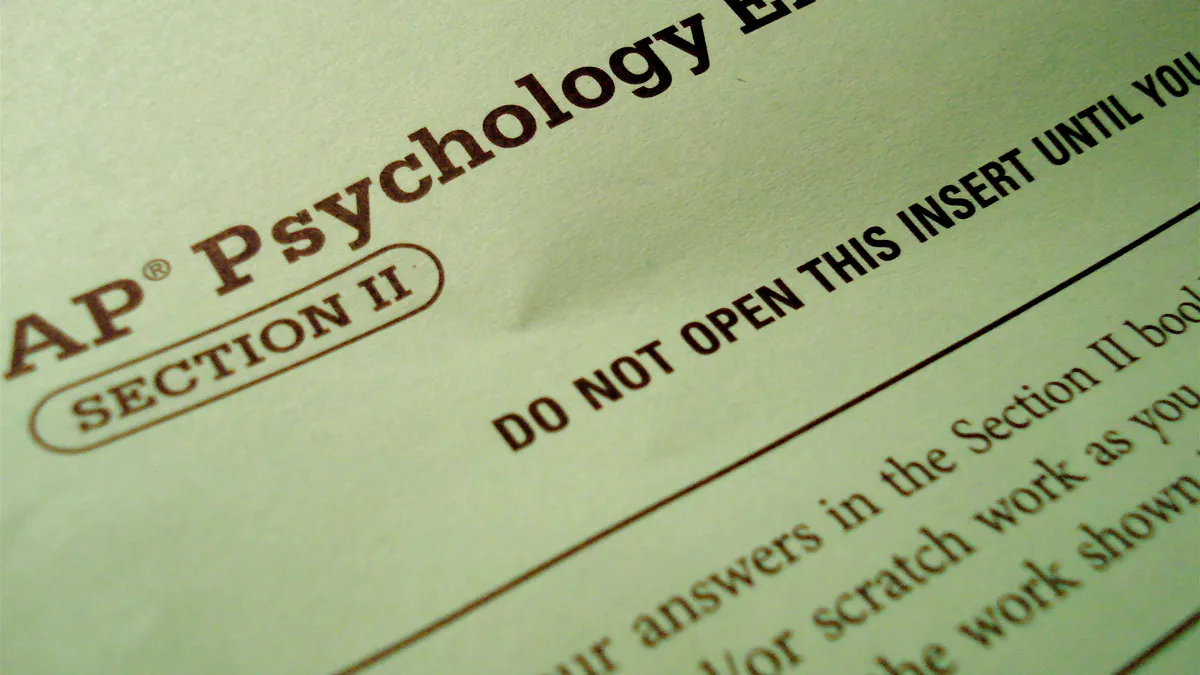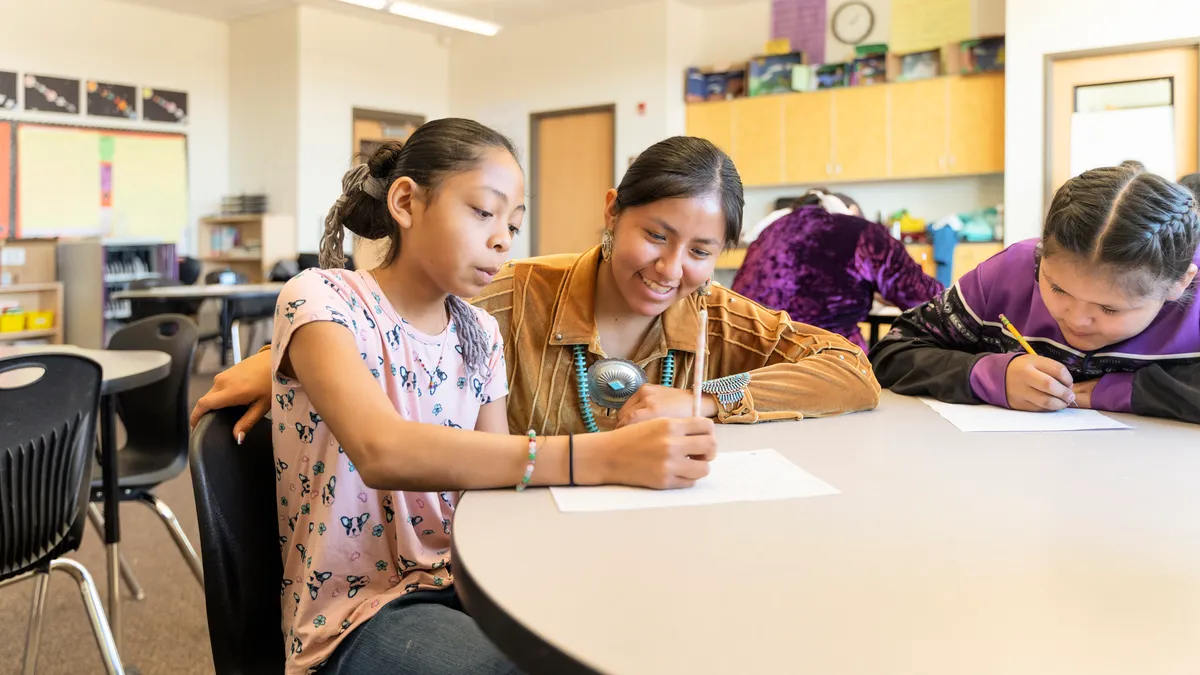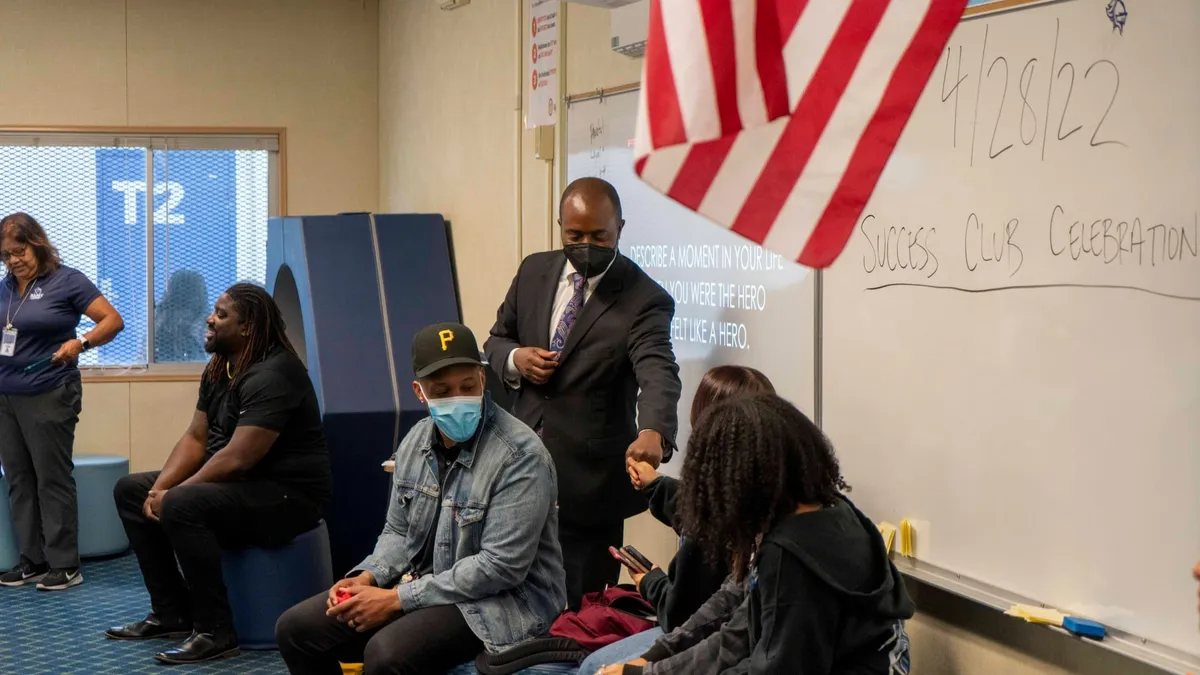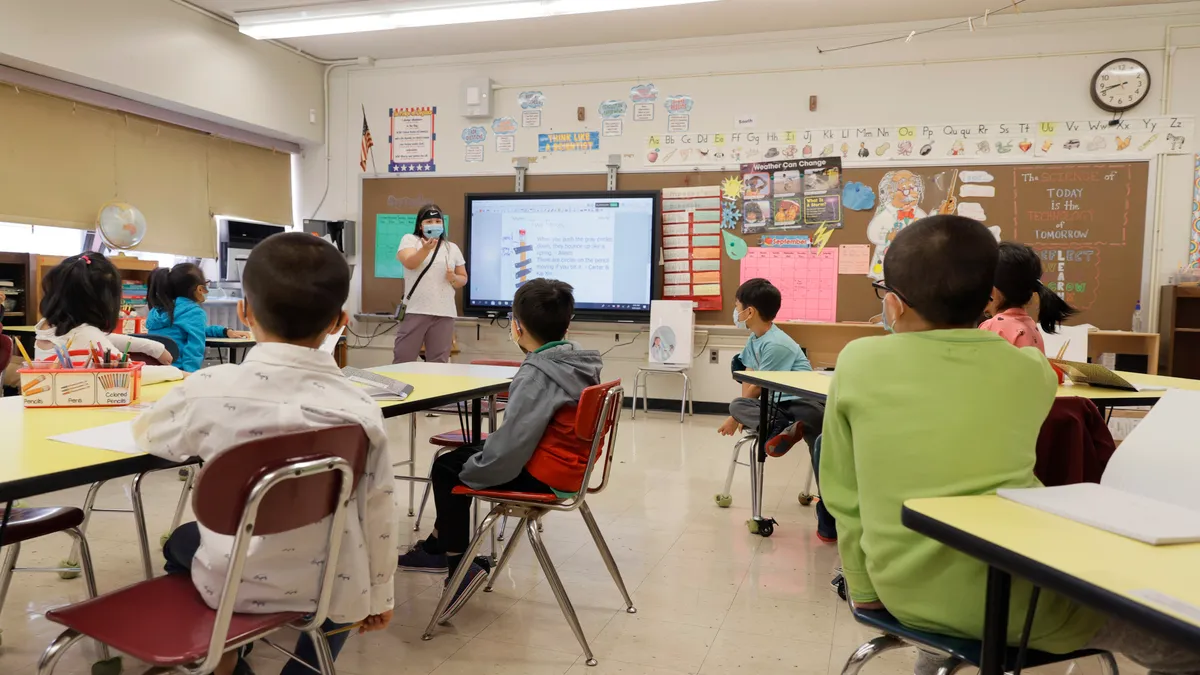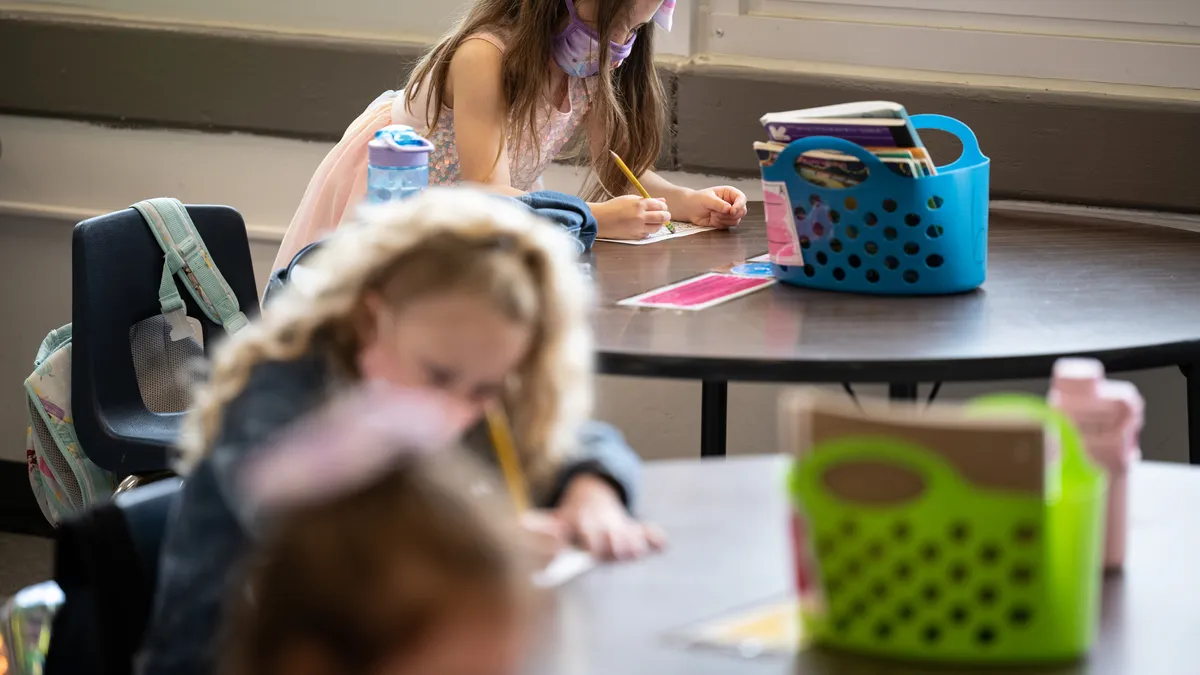Sara Sweetman, a University of Rhode Island (URI) assistant professor, still remembers pulling her car over to the side of the road in 2009 to take an important phone call.
Sesame Workshop was ready to bring science, technology, engineering and math (STEM) to the most famous street in America, and Rosemarie Truglio, senior vice president of curriculum and content, was calling on experts to advise Sesame Street’s writers on what STEM learning might look like with a muppet.
Sweetman — who ended up being cast in the role of the science teacher in a few episodes of Murray’s Science Experiments — remembers urging the show’s writers to leave the segments less scripted than they might have preferred.
“Kids are so fascinated by the world around them,” says Sweetman. “Their answers to questions are authentically entertaining.”
A former preschool and kindergarten teacher, who now trains future elementary teachers and works with school districts as part of URI’s Guiding Education in Math and Science Network, Sweetman is just one of many educators and researchers who have played a critical, behind-the-scenes role in making sure each scene and lesson is developmentally appropriate and scientifically accurate.
“I often bring one or two advisors to come in and review scripts,” Truglio says. “They have the expertise, and I want to make sure I’m getting it right.”
Lessons from Sesame
Getting it right has been Sesame Street’s intention from the beginning in 1969, when creators Joan Ganz Cooney and Lloyd Morrisett Jr. worked with Harvard University developmental psychologist Gerald Lesser to build the show’s unique approach to teaching through entertainment.
“If this would be a genuine learning vehicle, they would need a curriculum,” says Joe Blatt, a senior lecturer in the Harvard Graduate School of Education, which plans to mark its long relationship with what was then called the Children’s Television Workshop today with a “Sesame Live”-like stage show and dinner.
In a practice that continues today, Lesser led the process of bringing together researchers and content experts with the show’s creative team for a day-long seminar to plan the curriculum focus for each new season.
“He found ways to get everyone to collaborate,” says Blatt, who was recruited by Lesser to keep the relationship with Sesame going. In 2017, Sesame Workshop also worked with some of Blatt’s students to present him with a personalized muppet in appreciation for his role in sustaining the partnership. The character, he said, occasionally makes “a guest appearance on Appian Way” through the Harvard campus.
Blatt also teaches a course on how non-classroom environments — such as libraries, museums and even shopping centers — can contribute to children’s knowledge of the world. “The lessons that we try to learn from Sesame are about what makes for successful informal learning.”
‘One of my first teachers’
It’s a year of significant 50th anniversaries — the Apollo 11 mission, the Woodstock music festival and the Beatles' "Abbey Road" record to name a few. But it’s hard to match Sesame Street’s impact on generations of children — some of whom grew up to be teachers.
“It taught me the power of curiosity and kindness,” says Blair Mishleau, the director of personalized learning for the Western School of Science and Technology, a charter school in Phoenix, Arizona. “Growing up in a low-income family, I spent a lot of time put in front of the TV when my mom was studying for school or working. She often had me watch Sesame Street, and it was one of my first teachers.”
Cheryl Selden, who teaches at the Bergen Arts and Science Charter School in Garfield, New Jersey, remembers that the show made her think as a child.
“It has made me more aware of what doesn't meet the eye,” she says. “Sesame Street was always making us look at things and notice them. Whether the Count was counting, Cookie was eating, or Big Bird was talking to someone, there was always more there than we saw on the surface.”
Researchers have documented that those who watched Sesame Street — introduced when it wasn’t common for children to attend preschool — experienced better outcomes later in life than those who didn’t.
In just one example of how scholars have measured the show’s impact over time, economists Melissa Kearney and Phillip Levine compared households that received broadcast signals allowing them to view Sesame Street with those who didn’t live in those coverage areas. They found those exposed to the show were 14% more likely to be enrolled in the correct grade level for their age at middle and high school.
Results were stronger among boys, as well as black and Hispanic children. Later in life, those who lived in households that could receive the show were also more likely to have jobs and to earn higher wages.
At least one Sesame Street viewer also grew up to work on the show.
“I understood very early in my life why the show was so important,” says Anna Housley Juster, who worked at Sesame Workshop from 2000 to 2006. “I knew that I had learned from the educational content of the show as a child, but I also watched for long enough to then appreciate the genius in the delivery, the appeal for the adult viewer.”
She began on the show as an intern while earning a master’s in developmental psychology from Teacher’s College at Columbia University, then freelanced as a researcher and eventually worked for Truglio as director of content. She was responsible for ensuring that the curriculum objectives, developed in partnership with the experts, were “carefully integrated” into each script.
‘Well-known globally’
Over time, the show and other Sesame Workshop productions have evolved to address not only early academic skills, but other developmental areas researchers have found to be important for children’s success in school.
When the team wanted Cookie Monster to learn some self-control around his favorite treat, they called in Stephanie Carlson, a University of Minnesota developmental psychologist whose work focuses on children’s executive function skills.
“Sesame is so well-known globally,” says Carlson, “it sort of served as an endorsement of the importance of this topic, which was relatively unknown.”
Based on her work on how children can learn to distance themselves from something they can’t have right away, Cookie Monster pretends cookies are something undesirable, like a smelly fish. In a series of movie parodies, such as “The Hungry Games: Catching Fur,” Cookie also had to exercise patience.
Sesame’s characters also delicately address topics adults find hard to discuss. Following the terrorist attacks on Sept. 11, Juster participated in developing scripts that would “help preschoolers process themes such as loss, fear of fire and anger.”
She now works with children and families as a clinical social worker and educational consultant in Brookline, Massachusetts, and runs workshops on self-directed play for teachers and family child care providers.
Beyond the show, Sesame Workshop has applied its model to other environments in which young children are growing up.
Taking on tough family topics and uncomfortable social issues, such as homelessness, divorce, or having an incarcerated parent, Sesame Street in Communities features muppets in resources for families and educators. Working closely with organizations in local communities, the initiative, with support from the Robert Wood Johnson Foundation, includes professional development and services for families.
In response to the displacement of millions of refugee children, Sesame Workshop is also working with the International Rescue Committee to reach children in Iraq, Jordan, Lebanon and Syria with a customized version of Sesame Street, as well as other early education resources. And in partnership with Brac in Bangladesh — whose founder Fazle Hasan Abed just received the prestigious Yidan Prize for education — Sesame Workshop has developed video content and is supporting play-based learning in refugee settlements.
In addition, Sesame Workshop last month announced a partnership with the Chan Zuckerberg Initiative (CZI), which is supporting the development of a curriculum in The Primary School, an early-childhood and elementary school program in East Palo Alto. Public Prep charter school network in New York City and the FirstStepNYC in Brooklyn, New York, will serve as pilot sites for the program, and based on their feedback, the curriculum will be refined and shared with more schools.
‘Cutting-edge teaching and learning’
Content communicated through fuzzy characters has also become an exemplar for future teachers. “Sesame Street models cutting-edge teaching and learning that educators can learn from,” says Sweetman.
Clips from the show, for example, give educators practice on how to use digital media in their teaching. “Sesame episodes are great for the classroom because they are often short and can be shown all at once,” she said. “We do teach teachers to pause and ask questions just like they would if they are reading a book.”
Her students at URI watch a clip in which Zoe wants her pet rock, Rocco, to float. And Elmo is trying to help. Sweetman encourages the future educators to pause the video and have children offer solutions.
“Then they can watch the rest and compare and contrast their ideas to Zoe’s and Elmo’s and learn that there is more than one way to solve most problems,” she said.
At the University of Delaware, education professor Roberta Golinkoff has shared research articles on Sesame Street with her students, who are preparing to conduct their own research. Truglio even spoke over videoconference to her students in a course on translating the science of learning.
“They are helping me create the next generation of students who want to make a dent in the world and make it better for children and families,” Golinkoff said.
Golinkoff and Temple University researcher Kathy Hirsh-Pasek — authors of books on the importance of play in learning — were also among the brains behind “Esme and Roy,” a Sesame Workshop series for HBO on guided play.
“Environments are quite educational in themselves without the trappings of the ABCs and 123s,” Hirsh-Pasek says.
The characters demonstrate using mindfulness strategies to manage difficult emotions — an aspect of executive function researchers say is an important part of having a successful transition into school.
In preparing for a new season, the span of time between the Sesame Workshop’s research seminar and when key messages are transformed into humorous skits can take more than a year.
“The way in which that translation gets done, it’s a whole new way to view the very research that you wrote,” says Hirsh-Pasek, adding she also would like to see her partnership with the show go one step further. “My goal in life at this point it to become a muppet.”
But Blatt doesn’t plan to share that honor anytime soon.






 Dive Awards
Dive Awards
